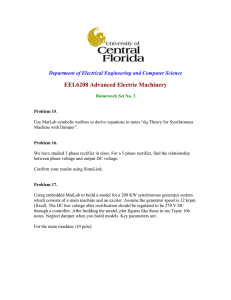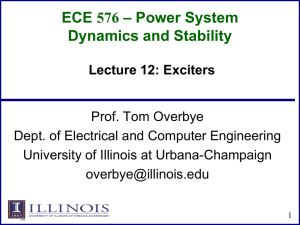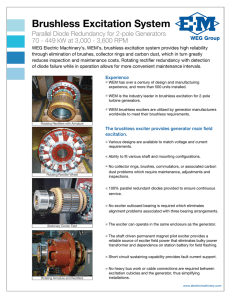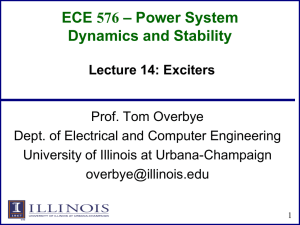Ear Exciting Exciter
advertisement
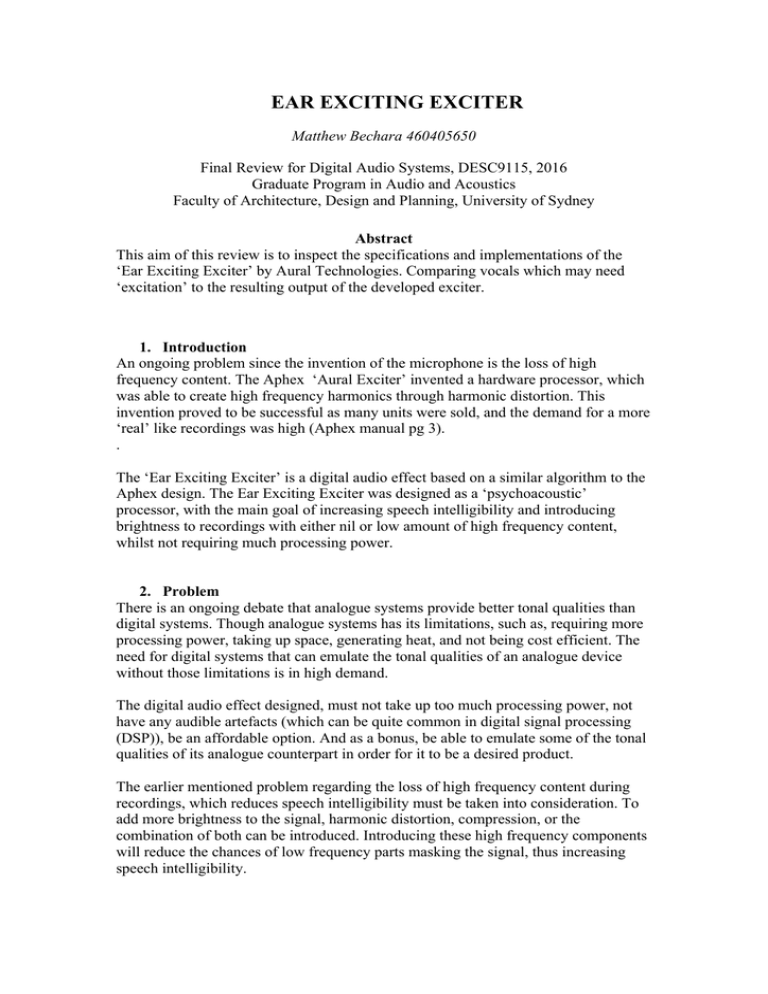
EAR EXCITING EXCITER
Matthew Bechara 460405650
Final Review for Digital Audio Systems, DESC9115, 2016
Graduate Program in Audio and Acoustics
Faculty of Architecture, Design and Planning, University of Sydney
Abstract
This aim of this review is to inspect the specifications and implementations of the
‘Ear Exciting Exciter’ by Aural Technologies. Comparing vocals which may need
‘excitation’ to the resulting output of the developed exciter.
1. Introduction
An ongoing problem since the invention of the microphone is the loss of high
frequency content. The Aphex ‘Aural Exciter’ invented a hardware processor, which
was able to create high frequency harmonics through harmonic distortion. This
invention proved to be successful as many units were sold, and the demand for a more
‘real’ like recordings was high (Aphex manual pg 3). .
The ‘Ear Exciting Exciter’ is a digital audio effect based on a similar algorithm to the
Aphex design. The Ear Exciting Exciter was designed as a ‘psychoacoustic’
processor, with the main goal of increasing speech intelligibility and introducing
brightness to recordings with either nil or low amount of high frequency content,
whilst not requiring much processing power.
2. Problem
There is an ongoing debate that analogue systems provide better tonal qualities than
digital systems. Though analogue systems has its limitations, such as, requiring more
processing power, taking up space, generating heat, and not being cost efficient. The
need for digital systems that can emulate the tonal qualities of an analogue device
without those limitations is in high demand.
The digital audio effect designed, must not take up too much processing power, not
have any audible artefacts (which can be quite common in digital signal processing
(DSP)), be an affordable option. And as a bonus, be able to emulate some of the tonal
qualities of its analogue counterpart in order for it to be a desired product.
The earlier mentioned problem regarding the loss of high frequency content during
recordings, which reduces speech intelligibility must be taken into consideration. To
add more brightness to the signal, harmonic distortion, compression, or the
combination of both can be introduced. Introducing these high frequency components
will reduce the chances of low frequency parts masking the signal, thus increasing
speech intelligibility.
3. Specification
The Ear Exciting Exciter uses a Chebyshev Filter algorithm for its high-pass filter, the
Chebyshev was chosen over the Butterworth design to create a steeper roll-off,
ensuring an accurate cut-off frequency, whilst only attenuating 0.05 dB in equiripple.
The user has the option to select the cut-off frequency to guarantee desired results.
Figure 1.
High-pass filter frequency response with a cut-off frequency of 2kHz.
The unit includes a compressor function with gain, threshold, ratio, attack and release
time as its variable input functions. The gain input occurs before the RMS of the
signal is taken, based on part of the design of the Urei 1177Ln (Urei 1176 manual pg
55).
The harmoniser function includes a user changeable option for either half-wave or
full-wave rectification, replicating the Aural Exciter’s design and creating even and
odd order harmonics.
4. Implementation
The exciter follows a similar signal flow to the Aphex ‘Aural Exciter’ as depicted in
figures 1 & 2. The input signal goes to the forward path, the side-path first includes a
high-pass filter, the output of the high-pass filter is then split into the harmoniser
system and the compressor system, the resulting outputs are then multiplied and
attenuated to compensate for the added gain, the signal is then summed with the
original input signal.
Figure 1. Signal flow of the Ear Exciting Exciter
Figure 2. Simplified signal flow of Aphex Aural Exciter (figure Chalupper pg. 11).
The implemented Chebyshev type 1 filter, is a Finite Impulse Response (FIR) version.
The formula used can be seen in Equation 1. A 40!! order filter has been included.
The order of N = 40 has been tested to ensure the right amount of roll off and passband equiripple.
N
𝐻 𝑧 =
𝑏! 𝑧 !!
n=0
Equation 1. Implemented FIR filter formula, where N = 40
The compressor function is based on code by M.Holters. Some minor changes have
been included to fit well with the exciter. Compressors use characteristic curves to
define ratio and slopes, they are CR > 1 and 0 < CS < 1 (Zolzer pg 110).
In Equation 2, gain is calculated. Where CR is the corresponding ratio, CS is the
characteristic curve
Equation 2. Compressor and expander formula, only the compressor formula is implemented in the Ear
Exciting Exciter. Gain calculated, RMS value is squared. Where ct is compression threshold and et is
expander threshold (figure Zolzer pg 111).
The added code to this compressor function is an additional pre-gain, where the signal
is multiplied by a user specified value (y = x * g), the signal is then attenuated by the
compressor’s threshold if the gain exceeds the predefined limit.
In this exciter, a harmoniser function using earlier mentioned half and full-wave
rectification is used. Taking the input signal and outputting the absolute value of the
signal, is one way of introducing harmonic distortion. Harmonic distortion is essential
for adding new harmonics to a signal. Whilst there are a few ways of producing
harmonic distortion, a DSP version of full-wave and half-wave rectification has been
implemented in the Ear Exciting Exciter, emulating the ‘Aural Exciter’s’ analogue
design.
Equation 3 and 4 shows the formula for both half and full-wave rectification in the
digital domain.
𝑓𝑤𝑟 = |𝑥! | Equation 3. Full-wave rectification (fwr) is simply the absolute value of the input signal.
ℎ𝑤𝑟 = 𝑥! + |𝑥! |
2
Equation 4. Half-wave rectification (hwr), the input signal is summed with the absolute value of the
input, then divided by 2, ensuring all negative values = 0.
5. Evaluation
Audio examples of the exciter being used with variable inputs have been included.
The test signal contains a vocal, which is lacking high frequencies and includes slight
masking on certain words. In tests 1-4 only 2 parameters are being changed, whilst
the other others remain a set value:
fc = 5000;
%Cutoff in Hertz
wc=2*fc/fs; %FIR inputs
N=40;
% Filter Order
type = 'high';
NC = N + 1; %Chebyshev inputs
NO = N - 10;
% Harmoniser inputs:
%hBP is the bypass for the harmoniser set at 1 to bypass
hBP = 0;
maxlevel = -6; % Max level for normalisation
% Compressor inputs:
gain = 3;
%Pregain
CT = -7;
%Threshold in dB
CS = 1.6;
%Slope (Ratio)
AT = 0.01;
%Attack Time
RT = 0.003;
%Release Time
harmtype = input('\n Would you like to use half-wave or full-wave
(rectification)?\n\n >','s');
Figure 3. MATLAB code, showing the user defined input arguments
The audio results of each of tests can be audibly compared to the original signal
(Vocal.wav). Audio results of test 1 (figure 3), can be referred to
‘5kHzFullWave.wav’. When comparing spectrally, it can be observed that there is an
increase and an addition of upper harmonic content as shown in figure 4.
Figure 4. Comparison of Vocal input and Vocal Output with a 5kHz cut-off using
full-wave rectification
In test 2, the cut-off frequency is changed to 2kHz and half-wave rectification is used.
Refer to audio file ‘’2kHzHalfWave.wav’ for a listening example. Again there is a
noticeable addition and increase of upper harmonics as shown in figure 5.
Figure 5. Test 2, A cut-off frequency of 2kHz using half-wave rectification is used.
Tests 3-4 can be compared audibly. Refer to ‘2kHzFullWave.wav’ for test 3 and
‘5kHzHalfWave.wav’ for test 4.
If the user wants to increase the high frequency content by a large amount, digital
artefacts can be heard. Refer to audio example ‘ExcessiveGain.wav’ for test 5, where
the input arguments are the same as figure 3, with the change of gain from 3 to 7.
After audibly comparing tests 1-4 to the original signal, it can be concluded that the
resulting output has increased and added new upper harmonics, thus increasing
speech intelligibility. However, if the inputs of each of the functions are overvalued,
the output may result in unwanted distortion.
It can be concluded that the Ear Exciting Exciter works as intended. Further
implementations would include a Graphic User Interface (GUI), which can also be
used to restrict user defined inputs, so that unwanted sound will not be easily achieved
by the user.
[1] Chalupper, J. (2000). AURAL EXCITER AND LOUDNESS MAXIMIZER:
WHAT’S PSYCHOACOUSTIC ABOUT "PSYCHOACOUSTIC
PROCESSORS" ? Audio Engineering Society Convention 109. Retrieved March
17, 2016.
[2] Zölzer, U. (2011). DAFX: Digital audio effects. Chichester: Wiley.
[3] Aphex: Aural Exciter Type III Model 250, Operating Guide and Service Manual
[4] Urei 1176ln Operating Guide and Service Manual
